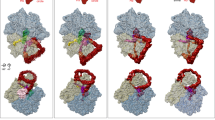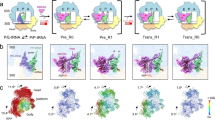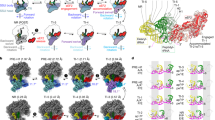Abstract
Bacterial ribosomes stalled at the 3′ end of malfunctioning messenger RNAs can be rescued by transfer-messenger RNA (tmRNA)-mediated trans-translation1,2. The SmpB protein forms a complex with the tmRNA, and the transfer-RNA-like domain (TLD) of the tmRNA then enters the A site of the ribosome. Subsequently, the TLD–SmpB module is translocated to the P site, a process that is facilitated by the elongation factor EF-G, and translation is switched to the mRNA-like domain (MLD) of the tmRNA. Accurate loading of the MLD into the mRNA path is an unusual initiation mechanism. Despite various snapshots of different ribosome–tmRNA complexes at low to intermediate resolution3,4,5,6,7, it is unclear how the large, highly structured tmRNA is translocated and how the MLD is loaded. Here we present a cryo-electron microscopy reconstruction of a fusidic-acid-stalled ribosomal 70S–tmRNA–SmpB–EF-G complex (carrying both of the large ligands, that is, EF-G and tmRNA) at 8.3 Å resolution. This post-translocational intermediate (TIPOST) presents the TLD–SmpB module in an intrasubunit ap/P hybrid site and a tRNAfMet in an intrasubunit pe/E hybrid site. Conformational changes in the ribosome and tmRNA occur in the intersubunit space and on the solvent side. The key underlying event is a unique extra-large swivel movement of the 30S head, which is crucial for both tmRNA–SmpB translocation and MLD loading, thereby coupling translocation to MLD loading. This mechanism exemplifies the versatile, dynamic nature of the ribosome, and it shows that the conformational modes of the ribosome that normally drive canonical translation can also be used in a modified form to facilitate more complex tasks in specialized non-canonical pathways.
This is a preview of subscription content, access via your institution
Access options
Subscribe to this journal
Receive 51 print issues and online access
$199.00 per year
only $3.90 per issue
Buy this article
- Purchase on Springer Link
- Instant access to full article PDF
Prices may be subject to local taxes which are calculated during checkout




Similar content being viewed by others
Accession codes
References
Keiler, K. C., Waller, P. R. & Sauer, R. T. Role of a peptide tagging system in degradation of proteins synthesized from damaged messenger RNA. Science 271, 990–993 (1996)
Moore, S. D. & Sauer, R. T. The tmRNA system for translational surveillance and ribosome rescue. Annu. Rev. Biochem. 76, 101–124 (2007)
Valle, M. et al. Visualizing tmRNA entry into a stalled ribosome. Science 300, 127–130 (2003)
Kaur, S. et al. Cryo-EM visualization of transfer messenger RNA with two SmpBs in a stalled ribosome. Proc. Natl Acad. Sci. USA 103, 16484–16489 (2006)
Weis, F. et al. Accommodation of tmRNA-SmpB into stalled ribosomes: a cryo-EM study. RNA 16, 299–306 (2010)
Weis, F. et al. tmRNA–SmpB: a journey to the centre of the bacterial ribosome. EMBO J. 29, 3810–3818 (2010)
Fu, J. et al. Visualizing the transfer-messenger RNA as the ribosome resumes translation. EMBO J. 29, 3819–3825 (2010)
Gutmann, S. et al. Crystal structure of the transfer-RNA domain of transfer-messenger RNA in complex with SmpB. Nature 424, 699–703 (2003)
Bessho, Y. et al. Structural basis for functional mimicry of long-variable-arm tRNA by transfer-messenger RNA. Proc. Natl Acad. Sci. USA 104, 8293–8298 (2007)
Shpanchenko, O. V. et al. Stepping transfer messenger RNA through the ribosome. J. Biol. Chem. 280, 18368–18374 (2005)
Petry, S. et al. Crystal structures of the ribosome in complex with release factors RF1 and RF2 bound to a cognate stop codon. Cell 123, 1255–1266 (2005)
Schuette, J. C. et al. GTPase activation of elongation factor EF-Tu by the ribosome during decoding. EMBO J. 28, 755–765 (2009)
Dorner, S., Brunelle, J. L., Sharma, D. & Green, R. The hybrid state of tRNA binding is an authentic translation elongation intermediate. Nature Struct. Mol. Biol. 13, 234–241 (2006)
Ermolenko, D. N. & Noller, H. F. mRNA translocation occurs during the second step of ribosomal intersubunit rotation. Nature Struct. Mol. Biol. 18, 457–462 (2011)
Loerke, J., Giesebrecht, J. & Spahn, C. M. Multiparticle cryo-EM of ribosomes. Methods Enzymol. 483, 161–177 (2010)
Dunkle, J. A. et al. Structures of the bacterial ribosome in classical and hybrid states of tRNA binding. Science 332, 981–984 (2011)
Gao, Y. G. et al. The structure of the ribosome with elongation factor G trapped in the posttranslocational state. Science 326, 694–699 (2009)
Jin, H., Kelley, A. C. & Ramakrishnan, V. Crystal structure of the hybrid state of ribosome in complex with the guanosine triphosphatase release factor 3. Proc. Natl Acad. Sci. USA 108, 15798–15803 (2011)
Ratje, A. H. et al. Head swivel on the ribosome facilitates translocation by means of intra-subunit tRNA hybrid sites. Nature 468, 713–716 (2010)
Spiegel, P. C., Ermolenko, D. N. & Noller, H. Elongation factor G stabilizes the hybrid-state conformation of the 70S ribosome. RNA 13, 1473–1482 (2007)
Yusupova, G. et al. Structural basis for messenger RNA movement on the ribosome. Nature 444, 391–394 (2006)
Passmore, L. A. et al. The eukaryotic translation initiation factors eIF1 and eIF1A induce an open conformation of the 40S ribosome. Mol. Cell 26, 41–50 (2007)
Spahn, C. M. et al. Hepatitis C virus IRES RNA-induced changes in the conformation of the 40s ribosomal subunit. Science 291, 1959–1962 (2001)
Spahn, C. M. et al. Cryo-EM visualization of a viral internal ribosome entry site bound to human ribosomes: the IRES functions as an RNA-based translation factor. Cell 118, 465–475 (2004)
Nameki, N., Tadaki, T., Himeno, H. & Muto, A. Three of four pseudoknots in tmRNA are interchangeable and are substitutable with single-stranded RNAs. FEBS Lett. 470, 345–349 (2000)
Wower, I. K., Zwieb, C. & Wower, J. Escherichia coli tmRNA lacking pseudoknot 1 tags truncated proteins in vivo and in vitro . RNA 15, 128–137 (2009)
Crandall, J. et al. rRNA mutations that inhibit transfer-messenger RNA activity on stalled ribosomes. J. Bacteriol. 192, 553–559 (2010)
Shen, L. X. & Tinoco, I., Jr The structure of an RNA pseudoknot that causes efficient frameshifting in mouse mammary tumor virus. J. Mol. Biol. 247, 963–978 (1995)
Michiels, P. J. et al. Solution structure of the pseudoknot of SRV-1 RNA, involved in ribosomal frameshifting. J. Mol. Biol. 310, 1109–1123 (2001)
Theimer, C. A., Blois, C. A. & Feigon, J. Structure of the human telomerase RNA pseudoknot reveals conserved tertiary interactions essential for function. Mol. Cell 17, 671–682 (2005)
Felden, B. et al. Probing the structure of the Escherichia coli 10Sa RNA (tmRNA). RNA 3, 89–103 (1997)
Márquez, V. et al. Maintaining the ribosomal reading frame: the influence of the E site during translational regulation of release factor 2. Cell 118, 45–55 (2004)
Suloway, C. et al. Automated molecular microscopy: the new Leginon system. J. Struct. Biol. 151, 41–60 (2005)
Chen, J. Z. & Grigorieff, N. SIGNATURE: a single-particle selection system for molecular electron microscopy. J. Struct. Biol. 157, 168–173 (2007)
Frank, J. et al. SPIDER and WEB: processing and visualization of images in 3D electron microscopy and related fields. J. Struct. Biol. 116, 190–199 (1996)
Penczek, P. A., Frank, J. & Spahn, C. M. A method of focused classification, based on the bootstrap 3D variance analysis, and its application to EF-G-dependent translocation. J. Struct. Biol. 154, 184–194 (2006)
Pettersen, E. F. et al. UCSF Chimera—a visualization system for exploratory research and analysis. J. Comput. Chem. 25, 1605–1612 (2004)
Selmer, M. et al. Structure of the 70S ribosome complexed with mRNA and tRNA. Science 313, 1935–1942 (2006)
Schuwirth, B. S. et al. Structures of the bacterial ribosome at 3.5 Å resolution. Science 310, 827–834 (2005)
Flores, S. C., Wan, Y., Russell, Y. & Altman, R. B. Predicting RNA structure by multiple template homology modeling. Pacif. Symp. Biocomput. 2010, 216–227 (2010)
Rother, M., Rother, K., Puton, T. & Bujnicki, J. M. ModeRNA: a tool for comparative modeling of RNA 3D structure. Nucleic Acids Res. 39, 4007–4022 (2011)
Yang, H. et al. Tools for the automatic identification and classification of RNA base pairs. Nucleic Acids Res. 31, 3450–3460 (2003)
Acknowledgements
We thank M. Muhs, T. Budkevich, M. Sommer and A. Korostelev for discussions. The strain for tmRNA overexpression and the plasmid for SmpB were provided by A. Muto. We also thank J. Buerger for his assistance during the cryo-EM data collection, E. Einfeldt for tRNA preparation and R. Albrecht for the preparation of the reassociated 70S ribosomes. This work was supported by grants from the Deutsche Forschungsgemeinschaft DFG (SP 1130/2-1 to C.M.T.S. and K.H.N., and SFB740 to C.M.T.S.), the German Academic Exchange Service (D/09/42768 to K.R.) and the European Union and Senatsverwaltung für Wissenschaft, Forschung und Kultur Berlin (UltraStructureNetwork, Anwenderzentrum) and the Alexander-von-Humboldt grant (GAN 1127366 STP-2 to H.Y.).
Author information
Authors and Affiliations
Contributions
H.Y., D.W., M.P., P.I., Y.T. and O.S. established the in vitro system for the reconstitution of ribosome–tmRNA complexes. H.Y. prepared the 70S–tmRNA–SmpB–EF-G complex. D.J.F.R. and T.M. collected the cryo-EM data. D.J.F.R., J.L. and C.M.T.S. carried out the image processing. D.J.F.R., K.R., P.S. and C.M.T.S. carried out the modelling of the full-length tmRNA. D.J.F.R., H.Y., K.R., K.H.N. and C.M.T.S. discussed the results and wrote the paper.
Corresponding author
Ethics declarations
Competing interests
The authors declare no competing financial interests.
Supplementary information
Supplementary Information
This file contains Supplementary Results and Discussion, Supplementary Tables 1-2, Supplementary References and Supplementary Figures 1-5. (PDF 6816 kb)
Rights and permissions
About this article
Cite this article
Ramrath, D., Yamamoto, H., Rother, K. et al. The complex of tmRNA–SmpB and EF-G on translocating ribosomes. Nature 485, 526–529 (2012). https://doi.org/10.1038/nature11006
Received:
Accepted:
Published:
Issue Date:
DOI: https://doi.org/10.1038/nature11006
This article is cited by
-
Multiplexed genomic encoding of non-canonical amino acids for labeling large complexes
Nature Chemical Biology (2020)
-
An overview of the bacterial SsrA system modulating intracellular protein levels and activities
Applied Microbiology and Biotechnology (2020)
-
Structures of Mycobacterium smegmatis 70S ribosomes in complex with HPF, tmRNA, and P-tRNA
Scientific Reports (2018)
-
Structural basis for ArfA–RF2-mediated translation termination on mRNAs lacking stop codons
Nature (2017)
-
Mechanistic insights into the alternative translation termination by ArfA and RF2
Nature (2017)
Comments
By submitting a comment you agree to abide by our Terms and Community Guidelines. If you find something abusive or that does not comply with our terms or guidelines please flag it as inappropriate.



